| |
Bicycle technology – then and now
Bicycles have come a long way. They are one of the most important methods of transportation ever created. Millions of people all over the world rely on them and enjoy them as both a primary means of transport and as a personal means of recreation.
Lifelong bicycle aficionados Rob van der Plas and Stuart Baird have indulged their passion for cycling and created a beautifully illustrated compendium dedicated to the technology and engineering that goes into the modern bicycle and its key components.
Their new book, titled Bicycle Technology, covers every detail and aspect of the modern bicycle, from the frame materials to the drivetrain, gears, to the wheels, suspension lights, bells and whistles, and more. They have shared their technical know-how and love of the history and the developments of the bicycle from its inauspicious beginnings to the use of space-age materials, and the incorporation of electronic innovations of today.
Contrary to popular belief, the first bicycle was invented by Carl Von Drais (no, not by Leonardo Da Vinci) in 1817. Drais viewed it as a substitute for a horse, which was in very short supply at the time due to a very harsh winter. His earliest machine was protected by a patent, which was soon copied by many people, some under license, some simply pirated. However, interest soon diminished, and by 1830, they were all but forgotten relics of a short-lived craze.
| |
|
|
| |
The original patent drawing that accompanied the 1817 patent application by Drais for the first bicycle. |
|
| |
|
|
| |
The pedal-drive was first introduced in the 1850s for use on a workman’s tricycle powered by means of cranks on the front wheel, and later found use on Michaux’s two-wheel velocipeds. Tension wire spokes were introduced in 1869, making it possible to build very large wheels of the iconic high-wheel, or “ordinary” bicycle of the 1870 and 1880s. |
|
The first chain-driven bicycle was patented in 1879. Within a few years of their introduction the safety bicycle, with chain-drive and two equal-sized had superseded the high-wheel bicycle. |
|
| |
|
|
|
|
| |
First patent for a pedal-driven bicycle, issued to Pierre Lallement in 1866. |
|
Foldable high-wheel bicycle, patented in 1879. Some assembly required. |
|
| |
|
|
|
|
| |
|
|
|
|
| |
English paratrooper with his folding bike that could be carried on his back during World War II. |
|
Modern folding bike being folded up to travel as airline luggage. |
|
| |
|
|
| |
During much of the 20th Century, bicycle developments were confined to “tweaking” the details rather than the overall re-design of the bicycle as a whole. |
|
| |
This 1870 Michaux tandem is believed to have been the first pedal-driven tandem bicycle compared to a modern tandem with aluminum frame and 30-speed gearing from Cannondale. |
|
| |
The most important development of the 20th Century was the introduction and perfection of gearing systems. |
|
| |
 |
|
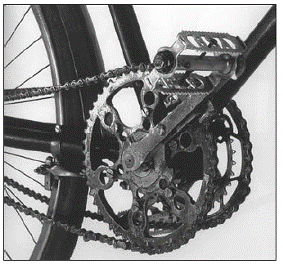 |
|
|
|
| |
This adaptation, referred to as “Kiddy Cranks,” allows a child on the rear seat of a tandem to reach the pedals. |
|
A 1910 touring bike with “bichain” (double chain) gearing. |
|
A modern bicycle derailleur gearing system in the process of changing gear by literally “derailing” the chain to a smaller or larger rear cog. |
|
| |
|
|
| |
Technical developments in bicycles continues to undergo tremendous refinements. There have been, and continue to be, significant developments in areas like brake systems and frame materials. High-tech, lightweight materials, including carbon and titanium, sometimes in combination, are now used in the frames and components of high-end bicycles. |
|
| |
|
|
|
|
|
|
| |
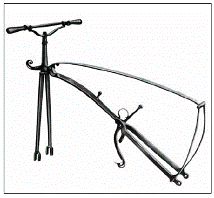 |
|
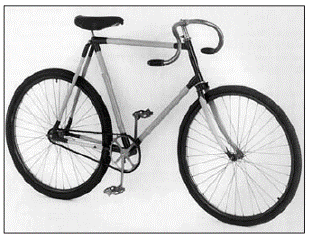 |
|
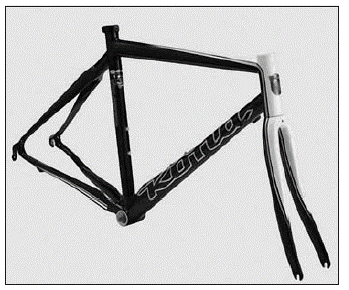 |
|
| |
The iron frame of a Michaux velocipede of around 1868. Note the use of a leaf spring to provide more comfort for the rider. |
|
An 1897 bicycle built up with bamboo tubing from the Austrian manufacturer Grunder & Lemisch. |
|
A modern road bike frame with front fork, both made entirely of carbon fiber. |
|
| |
|
|
| |
Many bicycles are now available with full suspension and hydraulic disk brakes. Fully equipped urban commuter bikes are available with carriers for a briefcase or laptop, effective lights for night riding, and other electronic and mechanical accessories. There are many types of bicycles. One can find road bikes, mountain bikes, city bikes, comfort bikes, touring bikes, trekking bikes, radonneur (long distance) bikes, racing bikes, folding bikes, tandems, cargo bikes, electric bikes (referred to as “e-bikes” or “pedelecs), recumbent bikes, tricycles, and even fully-enclosed pedal-driven machines. |
|
| |
|
|
| |
These illustrations show what was probably the first recumbent design, Challand’s “Normal Bicyclette” of 1897; the French bicycle racer Francis Faure riding a Mochet “Velocar” recumbent during a 1933 speed record attempt; and a modern fully-enclosed streamlined recumbent from the Dutch manufacturer M5. |
|
| |
|
|
| |
There are now four e-bike (electric bike) categories: CEBs, which are conventional electric bikes; SABs, or simple assisted bikes; EHBs, or electro-hybrid bikes; and SHBs, which stands for Synergetic Hybrid Bicycles. |
|
| |
|
|
| |
An early E-bike in action on a bicycle race track in 1898; a typical modern E-bike, the Panasonic Sugardrop, which is a favorite amongst Japanese housewives and also available in the US; and an electric conversion kit from the Canadian manufacturer BionX, which can be installed on almost any regular bicycle. |
|
| |
|
|
| |
Modern lighting systems of course, now use ultra-bright multi-light LEDs with rechargeable battery packs and on board generators. Modern audio warning systems are also electronic. No matter what advances in technology we may see, some people may still choose on installing an old-fashioned bell or horn. |
|
| |
|
|
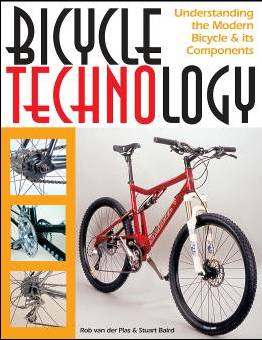 |
|
|
| |
|
|
Bicycle Technology
Understanding the Modern Bicycle and its Components
Rob Van Der Plas and Stuart Baird |
|
|
List US $39.95
8½ x 11 inch jacketed hardcover
320 pages with 800 black & white illustrations
ISBN: 978-1-892495-66-2
Published by Cycle Publishing, San Francisco, California |
|
|
| A thorough and up-to-date treatment of the technical aspects of the modern bicycle, illustrated with 800 photographs and other illustrations. This new, 2nd edition was completely rewritten, with up-to-date material and numerous clear illustrations, covering both the modern bike itself and its components in a historical context. Bicycle Technology explains every technical aspect of the modern bicycle in all its varieties—from road bike to downhill bike, and from folding bike to E-bike and recumbent. |
|
|
| |
|
|
For more information visit www.cyclepublishing.com |
|
|
| |
|
|
| |
About the authors |
|
| |
|
|
| |
Rob van der Plas is a mechanical engineer with a lifelong passion for the bicycle and its technology. His previous books include The Penguin Bicycle Handbook, The Mountain Bike Book, and Bicycle Repair. He lives in San Francisco. |
|
| |
|
|
| |
Stuart Baird is a retired avionics engineer with a passion for the bicycle and the ways its performance can be optimized. He lives in Devault, Pennsylvania. |
|
|
|

